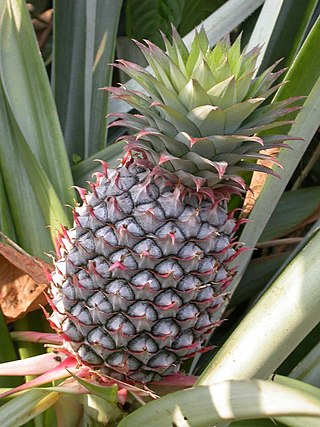
The Bromeliaceae are a family of monocot flowering plants of about 80 genera and 3700 known species, native mainly to the tropical Americas, with several species found in the American subtropics and one in tropical west Africa, Pitcairnia feliciana.
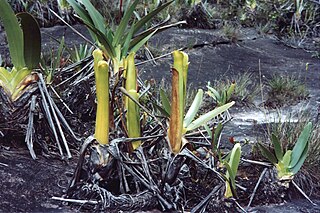
Brocchinia reducta is a carnivorous plant in the bromeliad family. It is native to southern Venezuela, Brazil, Colombia, and Guyana, and is found in areas with nutrient-poor, high moisture soil. B. reducta is able to grow in sparse conditions, which is evident when it uses its roots as anchors over rocks. Its funnel-like structure and waxy coating, among other characteristics, suggest that this plant is carnivorous.
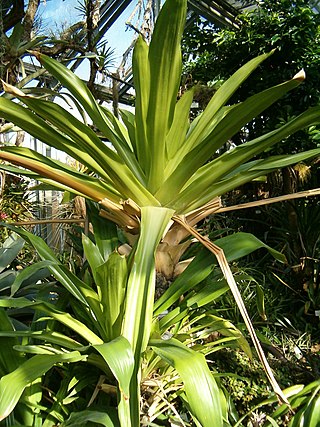
Brocchinia is a genus of the botanical family Bromeliaceae, and is the sole genus of the subfamily Brocchinioideae, containing 20 species. The genus is named for Giovanni Battista Brocchi, Italian naturalist (1772–1826). Brocchinia species are native primarily to the ancient Guayana Shield in southern Venezuela and Guyana, with some species extending into Colombia and northern Brazil. Its species are generally restricted to areas of sand and sandstone of the Roraima Formation; a few occur on granite.
Micrandra is a plant genus of the family Euphorbiaceae first described in 1854. It is native to South America.

Pouteria is a genus of flowering trees in the gutta-percha family, Sapotaceae. The genus is widespread throughout the tropical Americas, with outlier species in Cameroon and Malesia. It includes the canistel, the mamey sapote, and the lucuma. Commonly, this genus is known as pouteria trees, or in some cases, eggfruits.

Vriesea is a genus of flowering plants in the botanical family Bromeliaceae, subfamily Tillandsioideae. The genus name is for Willem Hendrik de Vriese, Dutch botanist, physician (1806–1862). Its species are widespread over Mexico, Central America, South America and the West Indies.
Brewcaria is a genus of plants in the family Bromeliaceae. The genus is named for Charles Brewer-Carías, Venezuelan explorer and naturalist. Some authorities treat Brewcaria as a synonym of Navia. It contains 6 known species, all native to Colombia and Venezuela.

Pitcairnioideae is a subfamily of the bromeliad family, Bromeliaceae. Traditionally, it was a large subfamily, comprising all those species with winged or more rarely naked seeds. Molecular phylogenetic studies showed that traditional Pitcairnioideae was not monophyletic, and the subfamily was more narrowly circumscribed. As of November 2022, the Encyclopaedia of Bromeliads placed five genera in the subfamily. Members of the subfamily are found from the Andes to the coast of Brazil, with one genus (Fosterella) found northwards to Mexico.

Pitcairnia is a genus of plants in the family Bromeliaceae, subfamily Pitcairnioideae. It was named for William Pitcairn, Scottish physician and gardener (1711–1791). The genus Pitcairnia ranks as the second most prolific of the bromeliad family. They are most abundant in Colombia, Peru and Brazil, but can also be found in areas from Cuba and Mexico south to Argentina. One species, Pitcairnia feliciana, is found in tropical West Africa and is the only member of the family Bromeliaceae not native to the Americas.
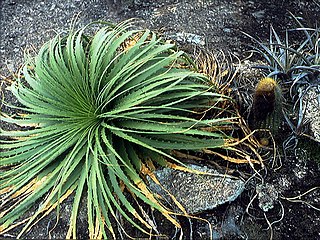
Encholirium is a genus of plants in the family Bromeliaceae, subfamily Pitcairnioideae. The entire genus is endemic to Brazil. The genus name is from the Greek “enchos” (spear) and “leiron” (lily).

Hohenbergia is a genus of plants in the family Bromeliaceae, subfamily Bromelioideae. It is native to the West Indies, the Yucatán Peninsula, and northern South America.

Greigia is a genus of plants in the family Bromeliaceae, subfamily Bromelioideae. It is native to Latin America from Mexico to Chile. The genus is named in honour of Major General Samuel Alexjewitsch Greig, president of the Russian Horticultural Society in 1865.
Steyerbromelia is a genus of plants in the family Bromeliaceae, subfamily Navioideae. All the known species in the genus are endemic to southern Venezuela, and northern Brazil and Colombia.
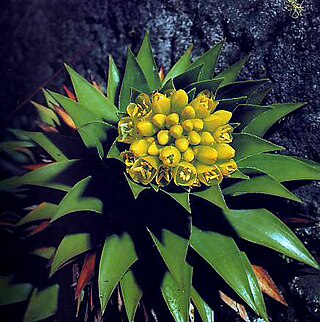
Lindmania is a genus of plants in the family Bromeliaceae. It is one of two genera in the subfamily Lindmanioideae, and contains 39 species. All but one of the known species are native to Venezuela, a few occurring in neighboring Guyana and northern Brazil).
Navia aliciae is a species of plant in the genus Navia. This species is endemic to Venezuela. It was first described by Lyman B. Smith and Harold Robinson.
Aechmea contracta is a species of flowering plant in the Bromeliaceae family. It is native to Venezuela, Colombia, Peru, Guyana and northern Brazil.

Odontadenia is a genus of plant in the family Apocynaceae, first described as a genus in 1841. It is native to southern Mexico, Central America, South America, and the West Indies.
- Odontadenia anomala(Van Heurck & Müll.Arg.) J.F.Macbr. - Peru, Bolivia
- Odontadenia campanulataJ.F.Morales - Colombia
- Odontadenia funigeraWoodson - Venezuela, Colombia, Ecuador, Peru, Brazil
- Odontadenia geminata(Hoffmanns. ex Roem. & Schult.) Müll.Arg. - 3 Guianas, Venezuela, Colombia, Ecuador, Peru, Bolivia, N Brazil
- Odontadenia glaucaWoodson - Amazonas State in S Venezuela
- Odontadenia gracilipes(Stadelm.) Woodson - Minas Gerais
- Odontadenia hypoglauca(Stadelm.) Müll.Arg. - Bolivia, Brazil
- Odontadenia killipiiWoodson - French Guiana, Venezuela, Colombia, Ecuador, Peru, N Brazil
- Odontadenia kochiiPilg. - Guyana, Venezuela, Colombia, Ecuador, Peru, N Brazil
- Odontadenia laxiflora(Rusby) Woodson - Peru, Bolivia, N Brazil
- Odontadenia lutea(Vell.) Markgr. - Peru, Bolivia, Brazil
- Odontadenia macrantha(Roem. & Schult.) Markgr. - Oaxaca, Chiapas, Central America, Trinidad & Tobago, 3 Guianas, Venezuela, Colombia, Ecuador, Peru, Brazil
- Odontadenia markgrafianaJ.F.Morales - French Guiana, N Brazil
- Odontadenia matogrossanaJ.F.Morales - Goiás, Mato Grosso
- Odontadenia nitida(Vahl) Müll.Arg. - Trinidad & Tobago, 3 Guianas, Venezuela, Colombia, Ecuador, Peru, Brazil, Bolivia
- Odontadenia perrottetii(A.DC.) Woodson - Venezuela, Colombia, Brazil, Bolivia, Guyana, French Guiana
- Odontadenia polyneura(Urb.) Woodson - Hispaniola
- Odontadenia puncticulosa(Rich.) Pulle - Central America, 3 Guianas, Venezuela, Colombia, Ecuador, Peru, Brazil, Bolivia
- Odontadenia stemmadeniifoliaWoodson - Venezuela, Colombia, Ecuador, Peru, Brazil
- Odontadenia verrucosa(Willd. ex Roem. & Schult.) K.Schum. ex Markgr. - 3 Guianas, Venezuela, Colombia, Ecuador, Peru, Brazil, Bolivia, Panama, Costa Rica, Nicaragua
- Odontadenia cuspidataRusby = Mandevilla cuspidata(Rusby) Woodson
- Odontadenia duckeiMarkgr. = Mandevilla pohliana(Stadelm.) A.H.Gentry
- Odontadenia glandulosa(Ruiz & Pav.) K.Schum. = Mandevilla glandulosa(Ruiz & Pav.) Woodson
- Odontadenia macrocalyx(Müll.Arg.) Miers = Tabernaemontana macrocalyxMüll.Arg.

Ecclinusa is a genus of plants in the family Sapotaceae described as a genus in 1839.
Chromolaena squalida is a South American species of flowering shrub in the family Asteraceae. It is found in Brazil, Paraguay, Bolivia, Peru, Colombia, Venezuela, Guyana, Suriname.

Navioideae is a subfamily of the bromeliad family, Bromeliaceae. It contains four or five genera, formerly placed in a more broadly defined subfamily Pitcairnioideae.















